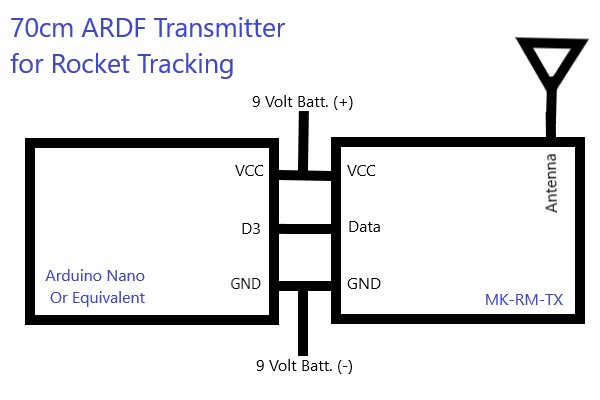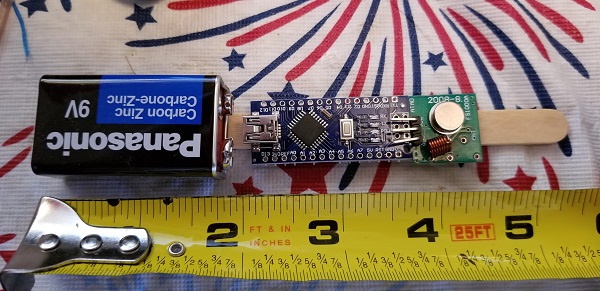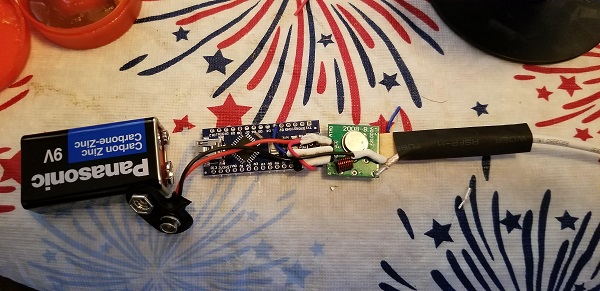
HOME Ham Projects Outward Links Links to this site
I came across these cheap UHF transmitter / receiver pairs while browsing Amazon.
The pair labeled XY-FST-RX / MK-RM-TX are only about $12 for six transmitters and six receivers. I purchased the package of the 433Mhz (70cm) version. The modules operate with AM on 433.92Mhz ISM band which is designed for basic data transmission (The band is popular for car remote locking, wireless doorbells, etc). Of course, this also puts it in the ham band, so I can use a bit higher voltage for a few more milliwatts and a better antenna.
The transmitter has 3 pins (Vcc, Data, Gnd) and a pad located in the top right for an antenna. I have not decided if I will use the receivers, but the transmitters look like they will be good for a simple rocket tracker.
I did a web search and found a project by Allan Gallop, M3RKV, for simple transmitter controlled by an Arduino Nano. He wrote a simple sketch, interpreting morse code: 0 - pause, 1 - dit and 2 - dah to control the timing of the pulses.
The circuit is very simple, with power being provided from a 9v transistor battery and the data being provided by a PWM digital pin on the Nano. I used an Arduino knock-off from Elegoo, available from Amazon for about $15 for a three pack. They come with the headers not installed, which is good for this kin of project that only uses three connections. In this simplified schematic the unused Nano pins are not shown.

Here is the sketch, based very closely on M3RKV's, since I hate to reinvent the wheel.
//Based on Fox Hunt sketch by M3RKV
//msg="moe"x15, w6dps
int msg[]=
\{2,2,0,2,2,2,0,1,0,0,2,2,0,2,2,2,0,1,0,0,2,2,0,2,2,2,0,1,0,0,2,2,0,2,2,2,0,1,0,0,2,2,0,2,2,2,0,1,0,0,2,2,0,2,2,2,0,1,0,0,2,2,0,2,2,2,0,1,0,0,2,2,0,2,2,2,0,1,0,0,2,2,0,2,2,2,0,1,0,0,2,2,0,2,2,2,0,1,0,0,2,2,0,2,2,2,0,1,0,0,2,2,0,2,2,2,0,1,0,0,2,2,0,2,2,2,0,1,0,0,2,2,0,2,2,2,0,1,0,0,2,2,0,2,2,2,0,1,0,0,2,2,0,2,2,2,0,1,0,0,2,2,0,2,2,2,0,1,0,0,2,2,0,2,2,2,0,1,0,0,2,2,0,2,2,2,0,1,0,0,2,2,0,2,2,2,0,1,0,0,1,2,2,0,2,1,1,1,1,0,2,1,1,0,1,2,2,1,0,1,1,1\};
int i;
int t;
void setup() \{
// set up pin 3 as output
pinMode(3, OUTPUT);
\}
void loop() \{
// main code here, to run repeatedly:
for(i=0;i<(sizeof(msg)/sizeof(int));i++)\{
delay(200);
if(msg[i]==0)\{t=450;\} //pause between letters
if(msg[i]==1)\{tone(3,800,100);t=100;\} //dit+delay between elements
if(msg[i]==2)\{tone(3,800,300);t=300;\} //dah(=ditx3)+delay between elements
delay(t);
\}
//1.5 second pause between messages
delay(1500);
\}
The tone() function is used to produce the signal required, where the first parameter is the Pin used, the second is the frequency and the third the duration in mS.
With my HT tuned to 433.920Mhz allowed me to hear the signal. Even without an antenna I was able to move at least 250 feet without loss of the signal, however even when placed directly next to the emitter the AF signal was not strong enough to break through the squelch on my HT despite it being on the lowest possible setting. With the coaxial dipole in the air and a four or six element yagi on the ground the system should have plenty of range.

I used a popsicle stick as an armature to mount the Arduino, transmitter board, and antenna. The boards moved around a bit before the glue set, so they are not really straight on this prototype. The antenna is a simple coaxial dipole made from RG-174 and 20 guage wire. This antenna yielded full-scale on the S-meter.

I used heat-shrink on the connections and to hold the antenna on the popsicle stick. I then wrapped the whole assembly in electrical tape. I did leave the USB port exposed. I plan to use tape or zip-ties to attache the transmitter and 9 volt battery to the rocket rigging.
Here is the finished transmitter. Audio is not great, since it is AM being detected by an FM receiver. It does move the S-meter pretty clearly. One change after the photos were taken: I found out the hard way it is not a good ida to tape over the reset button in the middle of the Nano.

I tested this at the Where you can get the Elegoo Nano Knock-off
Where you can get the transmitter module
Last updated 6/15/18